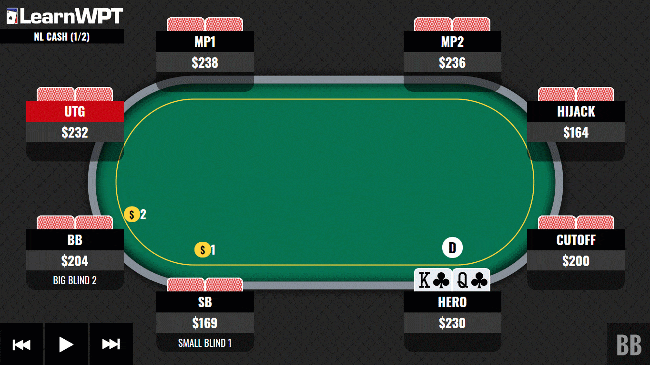K♣Q♣ vs a Check-Raise, what do you do?

DECISION POINT: In a live $1-2 game it folds to the player in the Cutoff who raises to $5. You reraise to $15 from the Button with K♣Q♣ and it folds to Cutoff who calls. Cutoff checks the K♥T♣3♠ flop, you c-bet $16 and get called. The turn is the K♦ and Cutoff checks. You bet $32 and your opponent check-raises to $96. Action is on you, what do you do here?
PRO ANSWER: In a $1-2 cash game we are dealt KQs on the Button. It is folded around to the Cutoff who raises to $5. KQs is an excellent hand to reraise on the Button here as it is ahead of Cutoff’s likely hand range and plays very well heads up in position. We reraise to $15 and it is folded back to the Cutoff who calls.
The flop is KhTc3s and the Cutoff checks to us. We have top pair with a good kicker and a backdoor flush and straight draw. This flop also significantly favors the preflop raiser’s range over the preflop caller’s range so this is an excellent spot to continuation bet. Given our range advantage and our hand’s lack of vulnerability (we block QJ, the most significant drawing hand here) a purely game theory optimal (GTO) strategy would have us betting closer to 1/4 to 1/3 pot here. We elect to use a slightly larger sizing of $16, or closer to half pot, and our opponent flat calls.
The turn is the Kd giving us three of a kind and our opponent checks to us again. AK is likely not a significant part of Villain’s range here as most players would have reraised preflop, so we’re well ahead of many of their hands and really only behind KTs/TT/33 that they may have played this way.
We bet $32 and our opponent check-raises to $96. Now, realistically we said the most likely hands that beat us here are KTs (of which there are 2 combinations left), TT, and 33 (of which there are 3 combinations each). That’s a total of 8 hands that beat us.
Continued below...
Our opponent could also be doing this with a hand like KJ (8 combinations left, although realistically they may only play the suited ones here), a slow played AA (6 combinations), the other KQ hands (3 combinations), and the occasional bluff. If we discount some of their KJ combinations (Villain likely would not play all the offsuit combinations) and AA combinations (they would sometimes reraise that hand preflop) this is actually a closer spot than it looks on first glance.
Since our hand is very close versus our opponent’s value raising range here, if we continue it is very important that we allow Villain to keep bluffing with some of their bluffing range (which may include AJ/AQ/QJ type hands). If we shove here we potentially get them to fold some bluffs they may shove the river with, costing us value.
When we’re behind our opponent is never folding anyway. Our hand is just too good to fold here so proceeding in a way which allows our opponent to get the rest of their money in with the widest range possible is best. We should call here with the plan of calling any river bet as well.
Calling is the best play.
What would you do here?
Share your answer in the comments below!
Ready to Advance Your Game?
Join us at Bellagio in Las Vegas for the Advanced Cash Game Strategy Workshop + Lab Day Session this December 7th - 9th
Be part of an intimate class of 30 students and learn these advanced strategies in person directly from LearnWPT Instructors Nick Binger, Andrew "LuckyChewy" Lichtenberger, and Eric Lynch.
Questions? Contact the Live Support Team at (888) 600-5593 or [email protected] and we’ll be happy to help.
P.S. Members Save Big on LearnWPT Workshops!
LearnWPT.com Members receive Preferred Pricing of up to $600 off on Live Workshops.
Not a Member? Click here for package deals!
